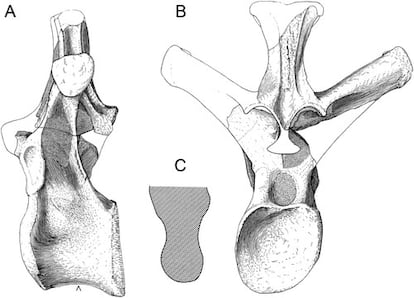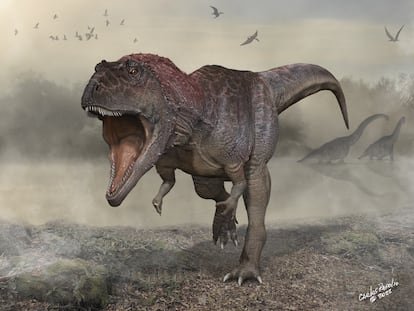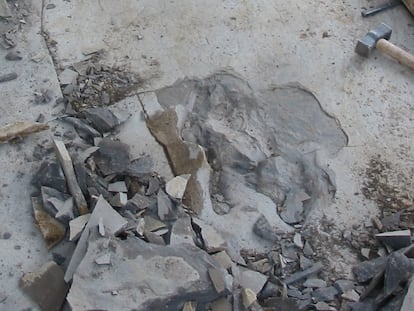The incredible story of how a new dinosaur species was discovered in Colombia
The bones of a four-legged herbivore that inhabited the tropics 175 million years ago were found in a remote area long controlled by FARC guerillas


About 175 million years ago, a herbivorous dinosaur with four thick legs, a tiny head and a very long neck and tail roamed the Serranía del Perijá mountain range in northern Colombia. This recently discovered species is the second dinosaur known to be of Colombian origin, and provides another clue to the evolutionary history of these prehistoric giants in South America.

“Can we say that we have a new Colombian dinosaur?” we ask. “Yes, definitely. This species does not seem to be related to dinosaurs that inhabited the tropics during the Early Jurassic Epoch,” replies Aldo Rincón, a professor at the Universidad del Norte in Barranquilla (northern Colombia) and lead author of the recent study published in the Journal of Vertebrate Paleontology. “The main differences between this dinosaur and others can be seen in the preserved morphology of the vertebra.” The team that studied the dinosaur and authored the article with Rincón includes paleontologist Jeffrey Wilson (University of Michigan, USA); museum curator Martín Ezcurra (Argentine Museum of Natural Sciences); geologist Harold Jiménez (Universidad EAFIT, Medellín, Colombia); and geologist Daniel Raad (Universidad del Norte, Baranquilla, Colombia).
The new dinosaur species is called Perijasaurus lapaz. “Perijá for the mountain range where the fossil was found and lapaz [the peace] to honor the 2016 peace agreement between the Colombian government and the FARC guerrillas,” said Raad. The peace agreement allowed scientists to access the remote area long controlled by the guerrillas.
Rincón recalls how the research team stayed at a special training and reintegration zone for ex-guerrillas who now work in ecotourism. “I liked having the opportunity to visit the Serranía del Perijá after the peace accords. Unfortunately, scientists couldn’t go there for many years,” said Rincón.

Giant fossils instead of oil
The story of the discovery of Perijasaurus lapaz begins on March 27, 1943. A geologist with the Tropical Oil Company found a heavy and strange-looking bone that did not seem to belong to any native fauna. The fossil was unearthed near a road between the Cesar and Ranchería river basins in the Serranía de Perijá mountain range. Instead of oil, the geologist had found a spinal vertebra from a dinosaur, but didn’t know it. He took the sediment-encrusted fossil to the United States and handed it over to the University of California, Berkeley. Twelve years later, a preliminary research study was published with the title “A sauropod dinosaur from Colombia” (Journal of Paleontology, 1955). The study did not identify the species, only that the fossil belonged to a sauropod – a long-necked herbivore – and gave no indication of the fossil’s scientific significance. The fossil was then forgotten for decades.
In 2018, 75 years after the fossil was discovered, paleontologist Jeffrey Wilson obtained a Fulbright grant to study the fossil with Aldo Rincón and the other scientists. They cleaned the bone, removed the decades-old plaster and glue, and discovered parts of the vertebra that didn’t seem to belong to a known species. “We were able to better visualize the delicate bony laminae that connected the spine, the intervertebral joints and the rib joints,” said Wilson in a press release issued by the Universidad del Norte.
The scientists then made 3D prints of the fossil and created the three-dimensional model that can be viewed on the University of Michigan’s Online Fossil Repository. But when the scientists discovered that the fossil had unique morphological features not seen in other species, they decided to try to pinpoint the location where the geologist had found the bone.

The old map
Back in 1943, the Tropical Oil Company geologists created a hand-drawn map showing the location and depth at which they found the fossil. “We created an overlay of a current map with the old map to identify the exact place where the vertebra was found,” said Daniel Raad. “Then we erected a stratigraphic column at the site to identify the [geological] layer where the vertebra came from.” The sediment that remained on the fossil helped them identify the right geological layer. “At the site, we found fragments of fossilized leaves and tree trunks, which indicates an environment with high preservation potential – in other words, where many fossils are likely to be found.”
According to Raad, the fossilized vegetation found near the vertebra revealed that Perijasaurus lapaz “lived in a riparian [adjacent to a body of water] wooded area with low slopes.” Raad and Rincón both highlighted the scientific importance of the finding – it’s not every day that a new dinosaur species is discovered, especially in Colombia. The region’s high heat and constant rain are difficult conditions for fossil preservation. In fact, when the large vertebra was discovered in 1943, it was the northernmost evidence of a sauropod in the Americas, the only one outside Patagonia, Argentina. Now, almost 80 years later, it still is.
“The importance of discovering a new genus and species in the tropics,” said Rincón, “is that it allows us to better understand the origins of sauropods and their ancestors, traces of which have been found in Cretaceous period rocks in Argentina.” Raad concurs, “The scientific relevance [of this discovery] is that that it helps us understand how these large dinosaurs evolved in the little explored tropics.”
Tu suscripción se está usando en otro dispositivo
¿Quieres añadir otro usuario a tu suscripción?
Si continúas leyendo en este dispositivo, no se podrá leer en el otro.
FlechaTu suscripción se está usando en otro dispositivo y solo puedes acceder a EL PAÍS desde un dispositivo a la vez.
Si quieres compartir tu cuenta, cambia tu suscripción a la modalidad Premium, así podrás añadir otro usuario. Cada uno accederá con su propia cuenta de email, lo que os permitirá personalizar vuestra experiencia en EL PAÍS.
¿Tienes una suscripción de empresa? Accede aquí para contratar más cuentas.
En el caso de no saber quién está usando tu cuenta, te recomendamos cambiar tu contraseña aquí.
Si decides continuar compartiendo tu cuenta, este mensaje se mostrará en tu dispositivo y en el de la otra persona que está usando tu cuenta de forma indefinida, afectando a tu experiencia de lectura. Puedes consultar aquí los términos y condiciones de la suscripción digital.
More information
Últimas noticias
Most viewed
- Sinaloa Cartel war is taking its toll on Los Chapitos
- Oona Chaplin: ‘I told James Cameron that I was living in a treehouse and starting a permaculture project with a friend’
- Reinhard Genzel, Nobel laureate in physics: ‘One-minute videos will never give you the truth’
- Why the price of coffee has skyrocketed: from Brazilian plantations to specialty coffee houses
- Silver prices are going crazy: This is what’s fueling the rally










































